Sour Cherry Varieties
Dwarf sour cherries are the result of over 50 years of breeding and selecting work by the University of Saskatchewan Fruit Program, culminating in the introduction of 'Carmine Jewel' in 1999—the first of its kind. Since then, Dr. Bob Bors expanded the collection with the Romance series, all bred for exceptional hardiness, compact dwarf size, and delicious, deep red fruit. Despite the name, sour cherries are actually sweet when fully ripe—don't be fooled by the first blush of red; they need time to develop their rich color and full flavor. These self-compatible cherries don’t require a second plant for pollination, making them ideal for smaller gardens. Grown on their own roots and hardy to Zone 2, they thrive when pruned into a shrub form, particularly in cold climates like the prairies and far north, where tree forms are more vulnerable to winterkill. Typically growing to just 2 meters (6 feet) tall, dwarf sour cherries are not only productive—bearing fruit as early as 4 or 5 years when trained as shrubs—but also stunning, with attractive spring blooms, interesting bark, and a striking appearance when heavy with fruit.
Musketeer Series
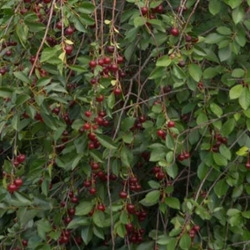
'D'Artagnan was released in 2021 in honour of the 100 Years of Horticulture Celebration at the University of Saskatchewan (USask). Its name comes from the fourth Musketeer of the 1800's tale of "The Three Musketeers", as it is the fourth variety released in the series. This variety is closely related to most of the Romance cherries having the same parents as Juliet, Valentine, and Crimson Passion. D’Artagnan suckers more frequently than the Romance series making it the best variety for homeowners that want a hedge of cherries.
'D'Artagnan is a cold-hardy sour cherry that produces small, sweet dark-red berries that are ready for harvest in early August. it is a shorter variety than most releases from the Romance Series. It suckers more frequentlly producing new high quality fruit from the original plant. Its shorter size and arching branches make it well suited for the sideways harvestors which bends the branches over the conveyor belt.
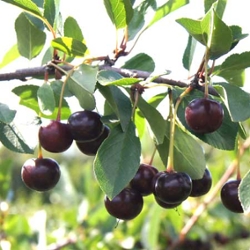
Athos was also released in 2022 continuing to honour 100 Years of Horticulture Celebrations at the University of Saskatchewan (USask). The growth habit of Athos is spreading rather than more upright growth. It produces heavy crops of medium sized dark red cherries with a sweet taste.
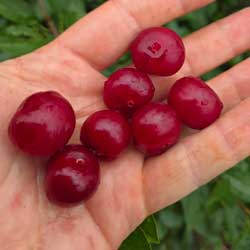
Porthos was released as one of four cherries in the Musketeer series of sour cherries. It is one of seven cherries released in 2022 by the the University of Saskatchewan fruit program celebrating the 100th anniversary of horticulture on the Prairies.
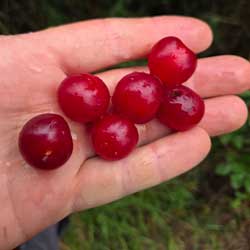
Aramis is not yet available to the public.
100th Anniversary of Horticulture Releases
Varieties released in honour of the 100 years of Horticulture Science on the Canadian prairies.
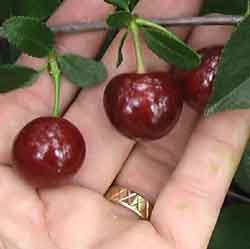
‘Sweet Thing’, is the result of a cross between ‘Carmine Jewel’ (the first sour cherry variety released from the USask program) and ‘Erdi Jubileum’ (a variety from Hungary).
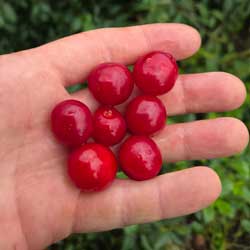
The Cutie Pie variety comes from the lineage of a collection of Mongolian sour cherry breeding material that was donated to the University of Saskatchewan by Les Kerr. Mr Kerr, Head of the Forestry Farm Shelterbelt Centre spent 40 years privately breeding cherries with the goal of developing a hardy sour cherry variety for the Prairies.
‘Cutie Pie’ has tasty, bright red cherries that are smaller than other cherries. It has an unusually dwarf growth habit growing about 4 feet tall measuring approximately half the height of other varieties in the USask cherry breeding program.
Big Red (Wowza)
Big Red is currently being marketed in the USA as ‘Wowza®’. The variety has unusually large red cherries that were 50% longer than wide with small lobes on the bottom appearing to look like a small apple.
The Romance Series
The Romance series of dwarf sour cherries was released in 2004. Varieties include 'Juliet', 'Romeo', 'Cupid', 'Valentine', and 'Crimson Passion'.
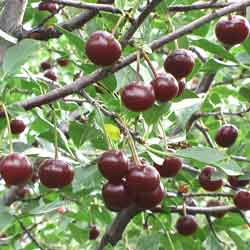
'Romeo' was first released in 2004 under the breeding number 7-7-5.8. As part of the Romance series of cherries, it is very similar to Carmine Jewel but it slightly later. It is very flavourful making it good for fresh eating and processing. It is one of the best varieties for those wanting to make a cherry juice.
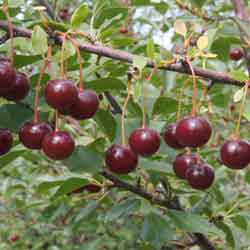
'Juliet' was first released in 2004 under the breeding number 21-32-0 and officially named 'Juliet' in 2006. As part of the Romance series of cherries, it is has the largest fruit size maximizing the size that will easily fit into a commercial cherry pitter. Its fruit color is an intense deep burgundy red and highly considered the best flavoured in the series and much preferred for fresh eating over processing.
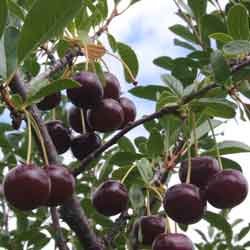
'Cupid' was first released in 2004 under the breeding number 7-32-19.1. As part of the Romance series of cherries, it is has the largest fruit size maximizing the size, but is too large for the standard commercial cherry pitter. Its fruit color is dark red to black and has a good balanced flavour for fresh eating. It tends to bloom one week later than the other varieties in the romance series earning it the nickname "Big and Late". It has very few suckers but is still considered consistent for the moderate producer. The pits are large enough to be removed with a hand crank pitter. Overall, Cupid is very different genetically from all of the other USask sour cherry cultivars.
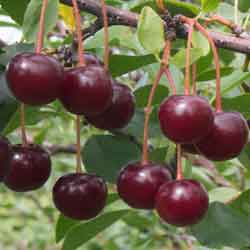
'Crimson Passion' was first released in 2004 under the breeding number 7-21-16.3. As part of the Romance series of cherries, it has the highest sugar content with a brix up to 22. Its fruit color is dark red and has excellent quality making it the best type for fresh eating but is also good for processing. Crimson Passion tends to have lower vigour and smaller yields, but it does not produce any suckers. The pits are large enough to be removed with a hand crank pitter.
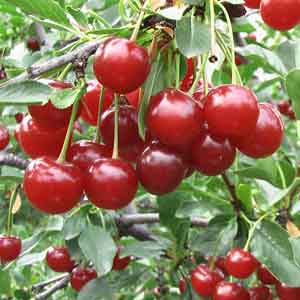
‘Valentine’ is the only variety in the Romance series that has red fruit. Other romance series varieties are burgundy or black when fully ripe. This variety is more vigourous than other Romance cherries and will produce a tree a foot or 2 taller than others. The extended height tends to lead to larger yields. "Valentine' has been reported to be one of the harder cherry varieties in the Romance series.
Carmine Jewel
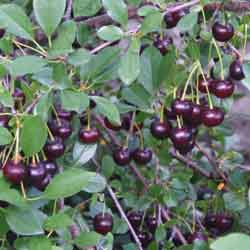
'Carmine Jewel' was released in 1999 and was the first sour cherry variety released by the USask fruit breeding program. By 2003 it was broadly planted and was the main cherry variety in commercial production on the Prairies.

